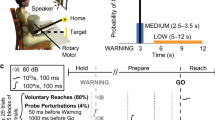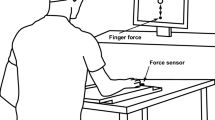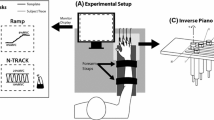Summary
We have previously shown that when aiming impulses of force to unpredictable flexion and extension targets, subjects prepare themselves to respond by preselecting a default amplitude and direction. In our preceding study, where flexion and extension target ranges were symmetrical, subjects prepared a single default amplitude near the center of each of the two ranges and selected a default direction arbitrarily (Favilla, Hening et al. 1989). Following target presentation, amplitude and direction were specified gradually and in parallel. By using an experimental paradigm in which target amplitudes had unequal probabilities in only one of the two directions, we no sought to determine to what extent the default amplitude prepared by subjects is dependent on the default direction that is selected for a given trial. Five normal subjects produced isometric elbow flexion and extension force impulses to match four targets requiring responses of two amplitudes in each direction. Flexion and extension targets were of the same size. In all biased probability conditions, targets were presented in unpredictable order and, in one direction, the probability of occurrence of the targets was biased (80% versus 20%). In the other direction, the two targets were equiprobable. To maximize the effect of the default settings on response parameters, we required subjects to initiate their response in synchrony with a predictable tone occuring less than a reaction time subsequent to the presentation of the visual target. Such a short interval was chosen to disclose the default parameters selected by limiting the influence of the target just presented on the amplitude and direction of the subjects' responses. If the default amplitude were prepared independently of the response direction selected, subjects should show a bias in the default amplitude in both directions. In contrast, if default amplitudes were associated with direction, the bias would occur only in the direction whose target amplitudes had unequal probability. For controls, we presented the same four targets both in predictable series (simple condition) and in unpredictable series without any bias (choice condition). When presented with targets whose amplitudes were of unequal probability in only a single direction, all subjects showed a strong bias in the amplitudes of their responses in both directions. This result was true of all subjects and occurred independently of the response direction (flexion or extension) or whether the response was in the same direction as the current target or the opposite direction (i.e. wrong direction). This bias was strongest when responses were made in the same direction as the targets with unequal probability. We conclude that subjects prepare default amplitudes that are, in large measure, independent of the direction of responses made to unpredictable targets. The present results expand our demonstration that subjects may perform different component processes of sensorimotor processing, such as specification of response amplitude and direction, by parallel processing channels.
Similar content being viewed by others
References
Favilla M, Hening W, Ghez C (1987) Independent specification of response features in a reaction time paradigm. Soc Neurosci Abstr 13:13
Favilla M, Hening W, Gordon J, Ghez C (1986) Preparatory set: independent specification of direction and size in the preparation of responses to a range of targets. Soc Neurosci Abstr 12:972
Favilla M, Hening W, Ghez C (1989) Trajectory control in targeted force impulses. VI. Independent specification of direction and amplitude. Exp Brain Res 75:280–294
Ghez C, Gordon J (1987) Trajectory control in targeted force impulses. I. Roles of opposing muscles. Exp Brain Res 67:225–240
Ghez C, Hening W, Favilla M (1990) Parallel interacting channels in the initiation and specification of motor responses. In: Jeannerod M (ed) Motor representation and control. Attention and performance XIII, 265–293
Gordon J, Ghez C (1987) Trajectory control in targeted force impulses. II. Pulse height control. Exp Brain Res 67:241–252
Hening W, Favilla M, Ghez C (1988) Trajectory control in targeted force impulses. V. Gradual specification of response amplitude. Exp Brain Res 71:116–128
Hening W, Vicario D, Ghez C (1988) Trajectory control in targeted force impulses. IV. Influences of choice, prior experience and urgency. Exp Brain Res 71:103–115
Kowler E, McKee SP (1987) Sensitivity of smooth eye movement to small differences in target velocity. Vision Res 27:993–1015
Kowler E, Martins AJ, Pavel M (1984) The effect of expectations on slow oculomotor control: anticipatory smooth eye movements depend on prior target motions. Vision Res 24:197–210
Poulton EC (1981) Human manual control. In: Brooks VB (ed) Handbook of physiology, Sect 1. The nervous system, Vol 2. Motor control. American Physiological Society, Bethesda, pp 1337–1389
Author information
Authors and Affiliations
Rights and permissions
About this article
Cite this article
Favilla, M., Gordon, J., Hening, W. et al. Trajectory control in targeted force impulses. Exp Brain Res 79, 530–538 (1990). https://doi.org/10.1007/BF00229322
Received:
Accepted:
Issue Date:
DOI: https://doi.org/10.1007/BF00229322




